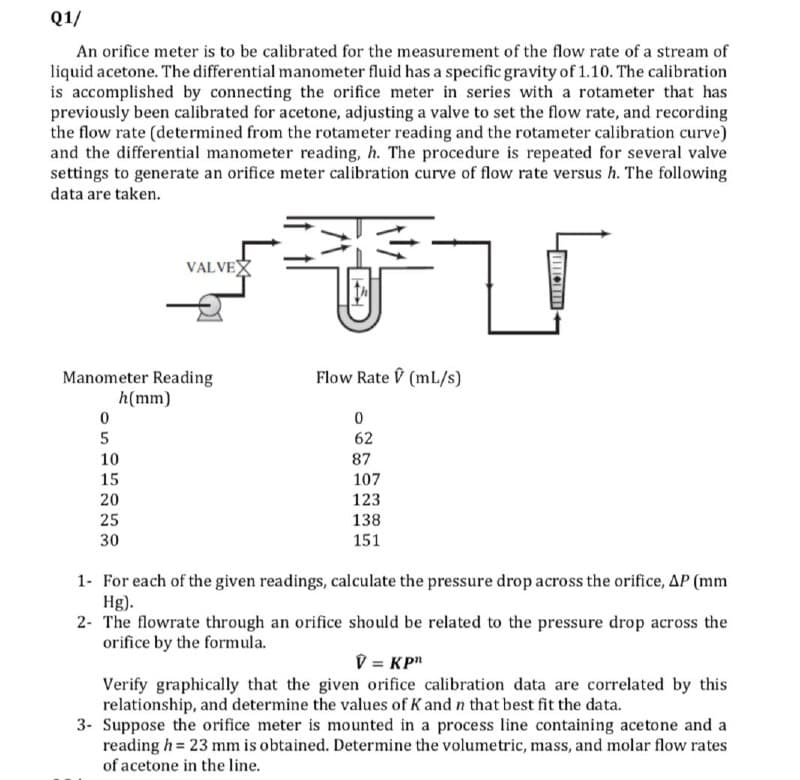An orifice meter is to be calibrated for the measurement of the flow rate of a stream of liquid acetone. The differential manometer fluid has a specific gravity of 1.10. The calibration is accomplished by connecting the orifice meter in series with a rotameter that has previously been calibrated for acetone, adjusting a valve to set the flow rate, and recording the flow rate (determined from the rotameter reading and the rotameter calibration curve) and the differential manometer reading, h. The procedure is repeated for several valve settings to generate an orifice meter calibration curve of flow rate versus h. The following data are taken. VALVEX Flow Rate V (mL/s) Manometer Reading h(mm) 62 10 87 15 107 20 123 25 138 30 151 1- For each of the given readings, calculate the pressure drop across the orifice, AP (mm Hg). 2- The flowrate through an orifice should be related to the pressure drop across the orifice by the formula. V = KP" Verify graphically that the given orifice calibration data are correlated by this relationship, and determine the values of K and n that best fit the data. 3- Suppose the orifice meter is mounted in a process line containing acetone and a reading h = 23 mm is obtained. Determine the volumetric, mass, and molar flow rates of acetone in the line.
An orifice meter is to be calibrated for the measurement of the flow rate of a stream of liquid acetone. The differential manometer fluid has a specific gravity of 1.10. The calibration is accomplished by connecting the orifice meter in series with a rotameter that has previously been calibrated for acetone, adjusting a valve to set the flow rate, and recording the flow rate (determined from the rotameter reading and the rotameter calibration curve) and the differential manometer reading, h. The procedure is repeated for several valve settings to generate an orifice meter calibration curve of flow rate versus h. The following data are taken. VALVEX Flow Rate V (mL/s) Manometer Reading h(mm) 62 10 87 15 107 20 123 25 138 30 151 1- For each of the given readings, calculate the pressure drop across the orifice, AP (mm Hg). 2- The flowrate through an orifice should be related to the pressure drop across the orifice by the formula. V = KP" Verify graphically that the given orifice calibration data are correlated by this relationship, and determine the values of K and n that best fit the data. 3- Suppose the orifice meter is mounted in a process line containing acetone and a reading h = 23 mm is obtained. Determine the volumetric, mass, and molar flow rates of acetone in the line.
Elements Of Electromagnetics
7th Edition
ISBN:9780190698614
Author:Sadiku, Matthew N. O.
Publisher:Sadiku, Matthew N. O.
ChapterMA: Math Assessment
Section: Chapter Questions
Problem 1.1MA
Related questions
Question

Transcribed Image Text:Q1/
An orifice meter is to be calibrated for the measurement of the flow rate of a stream of
liquid acetone. The differential manometer fluid has a specific gravity of 1.10. The calibration
is accomplished by connecting the orifice meter in series with a rotameter that has
previously been calibrated for acetone, adjusting a valve to set the flow rate, and recording
the flow rate (determined from the rotameter reading and the rotameter calibration curve)
and the differential manometer reading, h. The procedure is repeated for several valve
settings to generate an orifice meter calibration curve of flow rate versus h. The following
data are taken.
VALVEX
Flow Rate V (mL/s)
Manometer Reading
h(mm)
62
10
87
15
107
20
123
25
138
30
151
1- For each of the given readings, calculate the pressure drop across the orifice, AP (mm
Hg).
2- The flowrate through an orifice should be related to the pressure drop across the
orifice by the formula.
D = KP"
Verify graphically that the given orifice calibration data are correlated by this
relationship, and determine the values of K and n that best fit the data.
3- Suppose the orifice meter is mounted in a process line containing acetone and a
reading h= 23 mm is obtained. Determine the volumetric, mass, and molar flow rates
of acetone in the line.
Expert Solution
This question has been solved!
Explore an expertly crafted, step-by-step solution for a thorough understanding of key concepts.
This is a popular solution!
Trending now
This is a popular solution!
Step by step
Solved in 5 steps with 5 images

Knowledge Booster
Learn more about
Need a deep-dive on the concept behind this application? Look no further. Learn more about this topic, mechanical-engineering and related others by exploring similar questions and additional content below.Recommended textbooks for you

Elements Of Electromagnetics
Mechanical Engineering
ISBN:
9780190698614
Author:
Sadiku, Matthew N. O.
Publisher:
Oxford University Press

Mechanics of Materials (10th Edition)
Mechanical Engineering
ISBN:
9780134319650
Author:
Russell C. Hibbeler
Publisher:
PEARSON

Thermodynamics: An Engineering Approach
Mechanical Engineering
ISBN:
9781259822674
Author:
Yunus A. Cengel Dr., Michael A. Boles
Publisher:
McGraw-Hill Education

Elements Of Electromagnetics
Mechanical Engineering
ISBN:
9780190698614
Author:
Sadiku, Matthew N. O.
Publisher:
Oxford University Press

Mechanics of Materials (10th Edition)
Mechanical Engineering
ISBN:
9780134319650
Author:
Russell C. Hibbeler
Publisher:
PEARSON

Thermodynamics: An Engineering Approach
Mechanical Engineering
ISBN:
9781259822674
Author:
Yunus A. Cengel Dr., Michael A. Boles
Publisher:
McGraw-Hill Education

Control Systems Engineering
Mechanical Engineering
ISBN:
9781118170519
Author:
Norman S. Nise
Publisher:
WILEY

Mechanics of Materials (MindTap Course List)
Mechanical Engineering
ISBN:
9781337093347
Author:
Barry J. Goodno, James M. Gere
Publisher:
Cengage Learning

Engineering Mechanics: Statics
Mechanical Engineering
ISBN:
9781118807330
Author:
James L. Meriam, L. G. Kraige, J. N. Bolton
Publisher:
WILEY